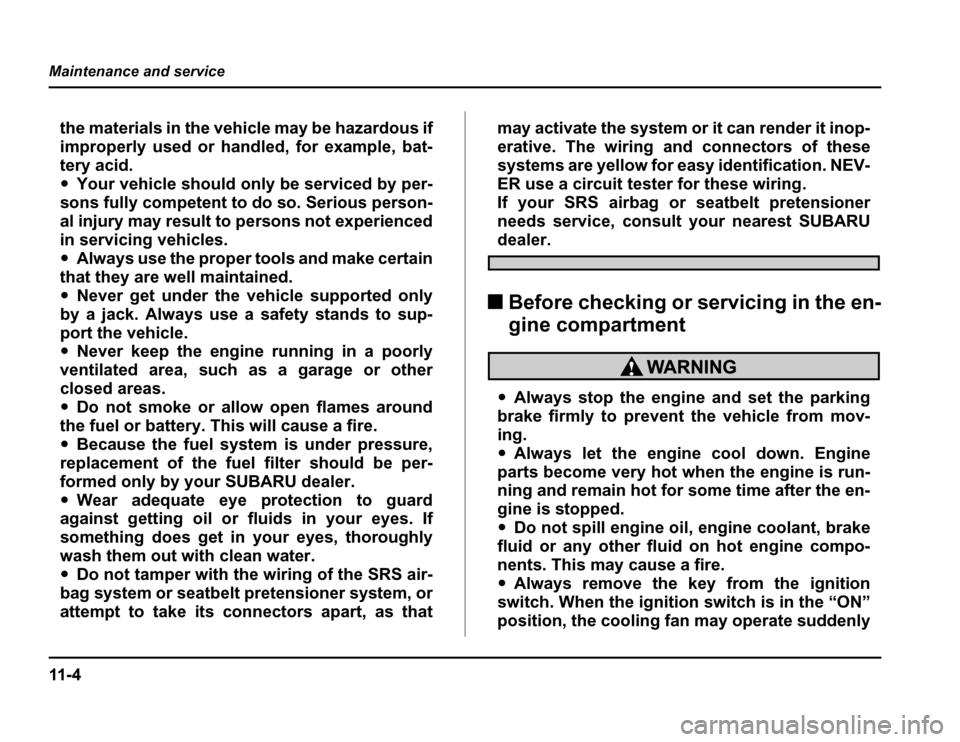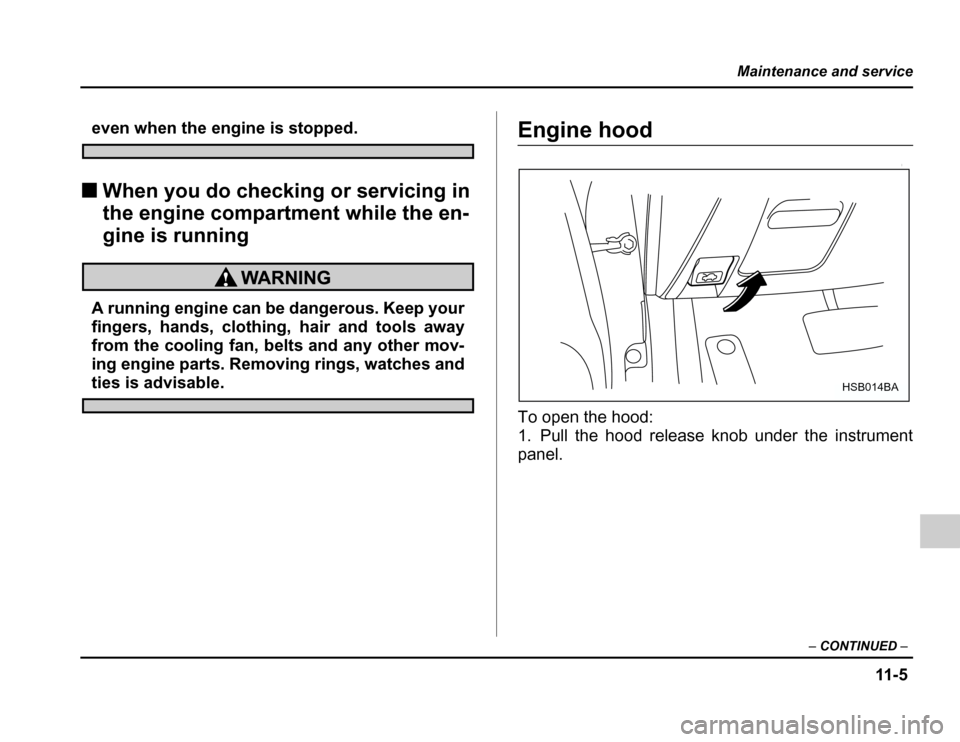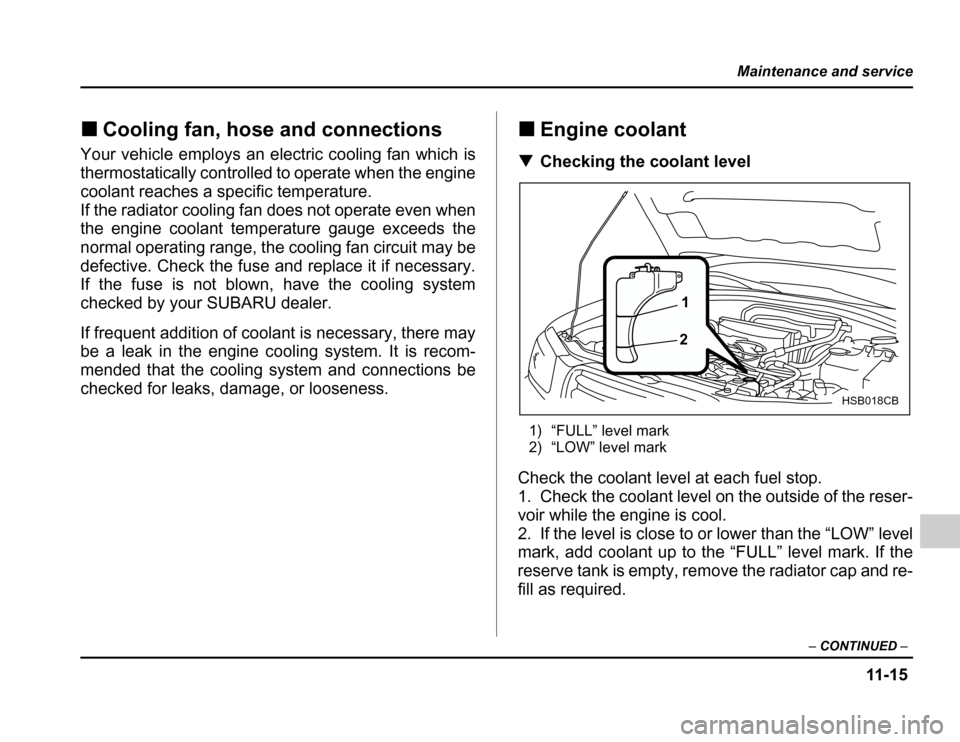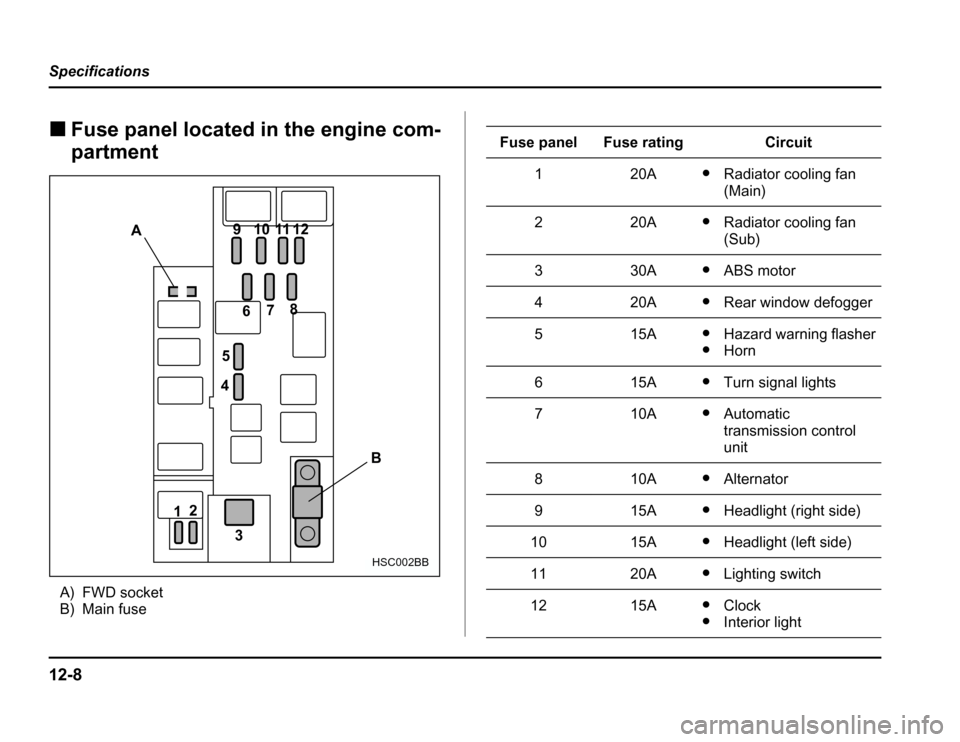2003 SUBARU FORESTER cooling
[x] Cancel search: coolingPage 317 of 420

9-12
In case of emergency
Engine overheating
Never attempt to remove the radiator cap until
the engine has been shut off and has fully
cooled down. When the engine is hot, the cool-
ant is under pressure. Removing the cap while
the engine is still hot could release a spray of
boiling hot coolant, which could burn you very
seriously.
If the engine overheats, safely pull off the road and
stopthevehicleinasafeplace. � If steam is coming from the engine compartment
Turn the engine off and get everyone away from the
vehicle until it cools down. � If no steam is coming from the engine compartment
1. Keep the engine running at idling speed.
2. Open the hood to ventilate the engine compart- ment. Confirm that the cooling fan is turning. If the fan is not
turning, immediately turn the engine off and contact
your authorized dealer for repair.
3. After the engine coolant temperature has dropped,
turn off the engine.
If the temperature gauge stays at the overheated
zone, turn the engine off.
4. After the engine has fully cooled down, check the
coolant level in the reserve tank.
If the coolant level is below the “LOW” mark, add cool-
ant up to the “FULL” mark.
5. If there is no coolant in the reserve tank, add cool-
ant to the reserve tank. Then remove the radiator cap
and fill the radiator with coolant.
If you remove the radiator cap from a hot radiator, first
wrap a thick cloth around the radiator cap, then turn
the cap counterclockwise slowly without pressing
down until it stops. Release the pressure from the ra-
diator. After the pressure has been fully released, re-
move the cap by pressing down and turning it.
Page 332 of 420

11 - 1
11
Maintenance and service
Maintenance schedule ................................ 11-3
Maintenance precautions ........................... 11-3 Before checking or servicing in the engine
compartment ................................................... 11-4
When you do checking or servicing in the
engine compartment while the engine is
running ............................................................. 11-5
Engine hood ................................................. 11-5
Engine compartment overview .................. 11-8
Engine oil ..................................................... 11-9 Checking the oil level ..................................... 11-9
Changing the oil and oil filter ........................ 11-10
Recommended grade and viscosity .............. 11-12
Recommended grade and viscosity under
severe driving conditions .............................. 11-14
Synthetic oil ..................................................... 11-14
Cooling system ............................................ 11-14 Cooling fan, hose and connections .............. 11-15
Engine coolant ................................................ 11-15
Air cleaner element ..................................... 11-19 Replacing the air cleaner element ................. 11-19
Spark plugs .................................................. 11-20 Recommended spark plugs ........................... 11-21
Drive belts .................................................... 11-21
Manual transmission oil .............................. 11-22 Checking the oil level ..................................... 11-22
Recommended grade and viscosity .............. 11-23
Automatic transmission fluid ..................... 11-24 Checking the fluid level .................................. 11-24 Recommended fluid ....................................... 11-25
Front differential gear oil (AT vehicles) ..... 11-26 Checking the oil level ..................................... 11-26
Recommended grade and viscosity ............. 11-26
Rear differential gear oil .............................. 11-27 Checking the gear oil level ............................ 11-27
Recommended grade and viscosity ............. 11-28
Power steering fluid ..................................... 11-29 Checking the fluid level .................................. 11-29
Recommended fluid ....................................... 11-30
Brake fluid .................................................... 11-30 Checking the fluid level .................................. 11-30
Recommended brake fluid ............................. 11-31
Clutch fluid (MT vehicles) ........................... 11-31 Checking the fluid level .................................. 11-31
Recommended clutch fluid ............................ 11-32
Brake booster ............................................... 11-32
Brake pedal ................................................... 11-33 Checking the brake pedal free play .............. 11-33
Checking the brake pedal reserve distance . 11-33
Clutch pedal (MT vehicles) .......................... 11-34 Checking the clutch function ........................ 11-34
Checking the clutch pedal free play ............. 11-34
Hill holder (MT vehicles — if equipped) ..... 11-35
Replacement of brake pad and lining ........ 11-35 Breaking-in of new brake pads and linings .. 11-36
Parking brake stroke ................................... 11-37
Tires and wheels .......................................... 11-37 Types of tires .................................................. 11-37
Page 335 of 420

11 - 4
Maintenance and service
the materials in the vehicle may be hazardous if
improperly used or handled, for example, bat-
tery acid. �
Your vehicle should only be serviced by per-
sons fully competent to do so. Serious person-
al injury may result to persons not experienced
in servicing vehicles. � Always use the proper tools and make certain
that they are well maintained. � Never get under the vehicle supported only
by a jack. Always use a safety stands to sup-
port the vehicle. � Never keep the engine running in a poorly
ventilated area, such as a garage or other
closed areas. � Do not smoke or allow open flames around
the fuel or battery. This will cause a fire. � Because the fuel system is under pressure,
replacement of the fuel filter should be per-
formed only by your SUBARU dealer.� Wear adequate eye protection to guard
against getting oil or fluids in your eyes. If
something does get in your eyes, thoroughly
wash them out with clean water. � Do not tamper with the wiring of the SRS air-
bag system or seatbelt pretensioner system, or
attempt to take its connectors apart, as that may activate the system or it can render it inop-
erative. The wiring and connectors of these
systems are yellow for easy identification. NEV-
ER use a circuit tester for these wiring.
If your SRS airbag or seatbelt pretensioner
needs service, consult your nearest SUBARU
dealer.
� Before checking or servicing in the en-
gine compartment
�Always stop the engine and set the parking
brake firmly to prevent the vehicle from mov-
ing. � Always let the engine cool down. Engine
parts become very hot when the engine is run-
ning and remain hot for some time after the en-
gine is stopped.� Do not spill engine oil, engine coolant, brake
fluid or any other fluid on hot engine compo-
nents. This may cause a fire.� Always remove the key from the ignition
switch. When the ignition switch is in the “ON”
position, the cooling fan may operate suddenly
Page 336 of 420

11 - 5
Maintenance and service
–CONTINUED –
even when the engine is stopped.
� When you do checking or servicing in
the engine compartment while the en-
gine is running
A running engine can be dangerous. Keep your
fingers, hands, clothing, hair and tools away
from the cooling fan, belts and any other mov-
ing engine parts. Removing rings, watches and
ties is advisable.
Engine hood
0
To open the hood:
1. Pull the hood release knob under the instrument
panel.
HSB014BA
Page 345 of 420

11 - 1 4
Maintenance and service
�
Recommended grade and viscosity
under severe driving conditions
If the vehicle is used in desert areas, in areas with very
high temperatures, or used for heavy-duty applica-
tions such as towing a trailer, use of oil with the follow-
ing grade and viscosities is recommended.
API classification SL or SJ: SAE viscosity No.:
30, 40, 10W-50, 20W-40, 20W-50
� Synthetic oil
You can use synthetic engine oil that meets the same
requirements given for conventional engine oil. When
using synthetic oil, you must use oil of the same clas-
sification, viscosity and grade shown in this owner’s
manual, and must follow the oil and filter changing in-
tervals shown in the maintenance schedule.
Cooling system
Never attempt to remove the radiator cap until
the engine has been shut off and has cooled
down completely. Since the coolant is under
pressure, you may suffer serious burns from a
spray of boiling hot coolant when the cap is re-
moved.
The cooling system has been filled at the facto-
ry with a high quality, corrosion-inhibiting,
year-around coolant which provides protection
againstfreezingdownto–33 °F(–36 °C). For
adding, use genuine SUBARU coolant or an
equivalent: a mixture of 50% soft water and 50%
ethylene-glycol basis coolant. Use of improper
coolants may result in corrosion in the cooling
system. It is important to maintain protection
against freezing and corrosion, even if freezing
temperatures are not expected. Never mix dif-
ferent kinds of coolant.
Page 346 of 420

11 -1 5
Maintenance and service
–CONTINUED –
�Cooling fan, hose and connections
Your vehicle employs an electric cooling fan which is
thermostatically controlled to operate when the engine
coolant reaches a specific temperature.
If the radiator cooling fan does not operate even when
the engine coolant temperature gauge exceeds the
normal operating range, the cooling fan circuit may be
defective. Check the fuse and replace it if necessary.
If the fuse is not blown, have the cooling system
checked by your SUBARU dealer.
If frequent addition of coolant is necessary, there may
be a leak in the engine cooling system. It is recom-
mended that the cooling system and connections be
checked for leaks, damage, or looseness. �
Engine coolant
� Checking the coolant level
1) “FULL” level mark
2) “LOW” level mark
Check the coolant level at each fuel stop.
1. Check the coolant level on the outside of the reser-
voir while the engine is cool.
2. If the level is close to or lower than the “LOW” level
mark, add coolant up to the “FULL” level mark. If the
reserve tank is empty, remove the radiator cap and re-
fill as required.
HSB018CB
1
2
Page 403 of 420

12-8
Specifications
�
Fuse panel located in the engine com- partment
A) FWD socket
B) Main fuse
A 12
3 B
4
5 6
78
91011
12
HSC002BB
Fuse panelFuse ratingCircuit
120A�
Radiator cooling fan (Main)
220A�Radiator cooling fan (Sub)
330A�ABS motor
420A�Rear window defogger
515A�Hazard warning flasher
� Horn
615A�Turn signal lights
710A�Automatic
transmission control
unit
810A�Alternator
915A�Headlight (right side)
1015A�Headlight (left side)
1120A�Lighting switch
1215A�Clock
� Interior light
Page 412 of 420

14-3
Index
Center console ............................................... 6-5
Charge warning light ...................................... 3-11
CHECK ENGINE warning light/Malfunction
indicator lamp ............................................. 3-10
Child restraint systems ................................... 1-30 Installation with seatbelt ............................ 1-33
Top tether anchorages .............................. 1-38
Child safety locks ........................................... 2-20
Chime Key ............................................................ 3-3
Seat belt .............................................. 1-15, 3-9
Cigarette lighter socket ................................... 6-11
Clock .............................................................. 3-16
Clutch (MT)
Fluid ........................................................... 11-31
Pedal ......................................................... 11-34
Coat hook ....................................................... 6-16
Coil tray .......................................................... 6-7
Convenience net ............................................ 6-7
Coolant ........................................................... 11-15
Cooling system ............................................... 11-14
Corrosion protection ....................................... 10-4
Cruise control ................................................. 7-31
Cruise control indicator light ........................... 3-15
Cup holders ..................................................... 6-8 D
Dashboard storage compartment ................... 6-6
Daytime running light system ......................... 3-19
Differential gear oil
Front (AT vehicles) .................................... 11-26
Rear ........................................................... 11-27
Dimensions ..................................................... 12-2
Disarming the system ..................................... 2-16
Disc brake pad wear warning indicators ......... 7-22
Dome light ...................................................... 6-2
Door locks ...................................................... 2-3
Door open warning light ................................. 3-14
Drive belt ........................................................ 11-21
Driving in foreign country ................................ 8-5
Driving tips............................................... 7-13, 8-6 E
Electronic brake force distribution (EBD) system 7-25
Emergency locking retractor (ELR) ................ 1-14
Engine Compartment overview .............................. 11-8
Exhaust gas (carbon monoxide) ................ 8-3
Hood .......................................................... 11-5
Oil .............................................................. 11-9
Coolant ...................................................... 11-15
Overheating ............................................... 9-12
Starting ...................................................... 7-9